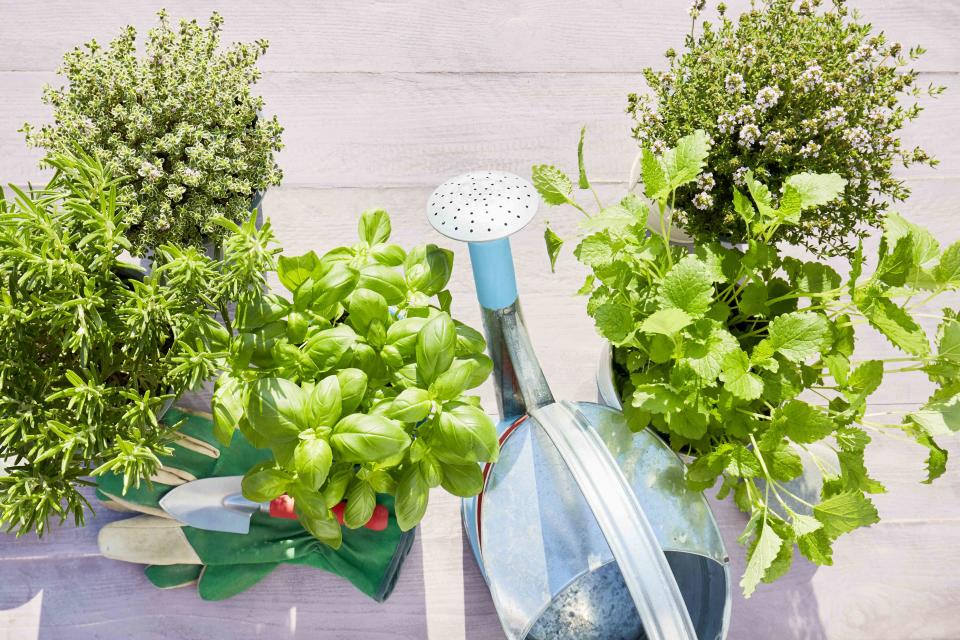5 Herb Combinations That Should Never Be Planted Together
And a few pairings that should.

The Burtons/Getty Images
There’s nothing quite like an herb garden. Beautiful and fragrant, there are so many things you can do with herbs, from enhancing meals to using them as decor. But like many types of gardens, you can’t just grab a shovel and start digging.
If you want your herb garden to thrive, it will take a little bit of planning—here are five combinations of herbs that should never be planted together, along with a few pairings that should.
Related: 4 Herbs You Should Always Plant Side-By-Side
Mint and Any Other Herb
Mint is a great herb to plant for lots of reasons. It smells fantastic and makes a great garnish in a cocktail—hello, homemade mojitos! It can even upgrade a plain old glass of water! So you might be very excited about planting it. However, it’s crucial to plant this herb alone.
According to Lindsay Etemadipour, holistic herbalist and founder of Symbi, a women-owned and operated small-batch tea shop, mint is highly invasive and can quickly overtake any garden space, crowding out other herbs.
So, yes it turns out you can have too much of a good thing. To control its spread, she advises planting mint in a container by itself. She adds, “It’s one of my favorite herbs to use daily, but if planted with other herbs, it will take over very quickly.”
Tips
You shouldn’t even plant mint next to mint. Courtney Sixx, founder of the DIY flower-arranging company Bouquet Box, says, “Different types of mint, such as spearmint and peppermint, should not be planted together, because they will each lose their unique taste and smell.”
Related: How to Store Mint So It Stays Fragrant and Fresh
Dill and Lavender, Majoram, Sage, or Parsley
Who doesn’t love some fresh dill in their soup or even sprinkled on a bagel with cream cheese? While you don’t need to plant it entirely in isolation, Sixx suggests keeping dill far from many herbs including lavender, marjoram, sage, and parsley.
She explains, “Dill attracts bugs that will harm and destroy those herbs,” she explains. Plus, dill requires moist soil, and the aforementioned herbs thrive in dry conditions.
Related: A Full Guide to Companion Plants for Your Garden
Sage and Chives
Sage can add a more nuanced, tasty flavor to chicken or fish. However, Sixx says it's best to keep it away from chives, which require a more moist soil than sage does.
Etemadipour adds that you're better off growing this herb next to thyme. According to her, “Sage and thyme need dry, well-drained soil and full sun to thrive. I like planting these two together because the strong scent of sage also repels pests from both herbs.”
Fennel and Any Other Herb
Fennel is a highly underrated herb. Great for salads and stews, it’s a true farm-to-table favorite. Much like mint, Sixx suggests planting it in isolation. “This plant is not invasive like mint, but it produces a chemical that can inhibit the growth of other herbs or vegetable plants. Planting fennel in a separate spot is best,” she says.
"“Fennel is finicky and seems to keep many plants from thriving close to them," Sixx adds."
Related: What Is Fennel—and How Do You Cook With It?
Basil and Sage
Basil is a great herb to grow at home because it's so versatile. However, experts advise planting it away from sage. Instead, Etemadipour highly recommends planting basil with oregano or parsley.
“I love pairing basil, parsley, and oregano because basil helps eliminate insects that are often attracted to oregano and parsley. These herbs thrive in similar conditions with plenty of sun and well-drained soil, making them a good pair at the end of things, too,” she says.
Related: The 12 Easiest Herbs to Grow Indoors
For more Real Simple news, make sure to sign up for our newsletter!
Read the original article on Real Simple.


